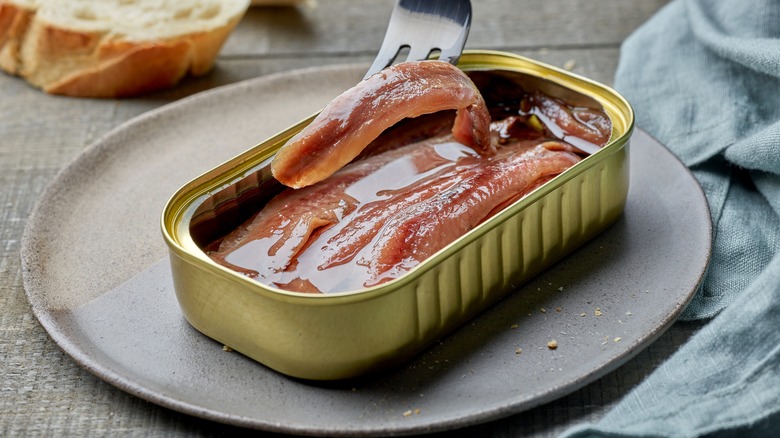What's The Difference Between Brown And White Anchovies?
Anchovies are a controversial ingredient; some people appreciate their salty, fragrant (yet pungent) flavor, while others are appalled by their appearance, texture, and taste (per Giadzy). Different varieties of these small fish are found all over the world, and they are used in an abundance of dishes to add that savory umami that our taste buds love. When it comes to choosing a variety of fish, the NOAA recommends consuming wild-caught anchovies found in the United States because they are sustainably harvested.
Anchovies are more common in cooking than you might recognize. If you're dining at a restaurant and order a Caesar salad, you can be almost certain that the house-made dressing contains anchovies; they're also often used in fresh pasta sauces.
Part of what affects an anchovy's flavor is how the fish is processed. There are two main types of processed anchovies; some have a deep brown hue, while others are a brighter white color. What's the difference between these two types of the same fish?
What are white anchovies?
When it comes to an anchovy's color and flavor, the biggest reason for the difference is whether or not the fish was cured between the ocean and your plate. White anchovies are anchovies that have not been cured, and as a result, they retain their original color. According to Cook's Illustrated, these anchovies are still salted before they're packaged, but not nearly to the extent of the cured fish. They are typically packed in oil and vinegar, and they should be refrigerated after purchase.
White anchovies have a relatively mild, sweeter flavor compared to their cured counterparts, and rather than being a flavor enhancement in recipes, they are often the stars of the show when used, such as being served over crostini. SBS says these fish are usually served on their own and are common in tapas dishes. According to the Environmental Defense Fund, the fish can be sourced from Europe, North America, South America, and Japan.
What are brown anchovies?
While white anchovies are served filleted and uncured, the brown fish are the opposite — they're filleted and fully cured in a salty solution. According to University of Georgia, the curing process refers to using salt and nitrates or nitrites to preserve a food product. The process can sometimes include sugar, though that is often referred to as pickling and is more common in vegetables than meat or fish.
Brown anchovies have been cured; the salt helps to draw out the water, which changes the fish's color to a deep brown, per Cook's Illustrated. Brown anchovies have a stronger umami flavor, and this makes them better used as an enhancement (such as in a salad dressing or pasta sauce) rather than served on their own. The curing time ranges for these fish, but it's usually several months, and they are then canned and sold in grocery stores; they do not need to be refrigerated until they are opened. According to Musco Food Corporation, the fish are gutted and then cured, but they are not filleted until after the curing process is complete and just before they are canned for consumption.


